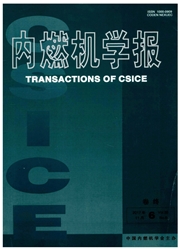

 中文摘要:
中文摘要:
在增压中冷发动机上采用柴油/含水乙醇组合燃烧(DECC)方式进行排放特性的试验研究。研究表明,采用DECC方式,增压中冷发动机的NOx和微粒排放同时大幅度下降,但HC和CO排放增加较多。加装氧化催化转化器后,HC和CO得到了大幅度地降低,微粒(PM)也进一步减少。按照国Ⅲ规定的检测方法,对比纯柴油排放,该机的NOx由6.49g/(kW·h)降到3.46g/(kW·h),微粒由0.142g/(kW·h)降到0.089g/(kW·h),HC和CO测量值分别为0.34g/(kW·h)和0.10g/(kW·h)。负荷烟度(ELR)试验测试结果为0.687m^-1。测试结果表明,采用DECC燃烧模式,在仍然采用原机的泵管嘴燃油喷射系统的情况下可以使增压中冷发动机排放从国Ⅱ排放标准提升到国Ⅲ排放标准。除微粒指标满足国Ⅲ要求外,其余指标低于国Ⅳ要求,且燃料经济性基本保持不变。
 英文摘要:
英文摘要:
Experimental study on simultaneously reduction of NOx and PM emissions of diesel/ethanol containing water compound combustion (DECC) in a turbocharged inter-cooled diesel engine. The results show that NOx and PM are decreased remarkably with the penalty of HC and CO increasing. The later can be reduced by DOC( diesel oxidation catalytic converter). Using the fuel delivery system of the baseline engine, the emission in DECC can meet the national phase Ⅲ emission standard based on the baseline engine in a national phase Ⅱ engine. According to the national phase Ⅲ specified test requirement, NOx from the DECC diesel engine is reduced from 6.49 g/( kW · h) of the baseline engine to 3.46 g/( kW · h) ,PM is reduced from 0. 142 g/(kW · h) to 0.089 g/(kW · h) ,HC is increased from 0. 237 g/(kW · h) to0.34 g/(kW· h ) , CO is increased from 0. 081 g/(kW·h) to 0. 10 g/(kW· h). The results are even lower than the national phase m emission standard. The result of ELR ( Europe load response test) shows exhaust smoke of 0. 687 m ^-1 which is lower than national phase Ⅲ emission standard. It is a feasible approach to decrease exhaust PM emission by using DECC in a turbocharged inter-cooled diesel engine. Exhaust pollutants except PM meet national phase Ⅳ without decreasing fuel economy.
 同期刊论文项目
同期刊论文项目
 同项目期刊论文
同项目期刊论文
 Experimental Investigation on the performance, gaseous and particulate emissions of methanol fumigat
Experimental Investigation on the performance, gaseous and particulate emissions of methanol fumigat Experimental Study on the Emissions Characteristics of a Diesel Engine Fueled with Biodiesel and Fum
Experimental Study on the Emissions Characteristics of a Diesel Engine Fueled with Biodiesel and Fum Comparison of Emissions of a Direct Injection Diesel Engine Operating on Biodiesel with Emulsified a
Comparison of Emissions of a Direct Injection Diesel Engine Operating on Biodiesel with Emulsified a Recent Applications of Synchrotron VUV Photoionization Mass Spectrometry: Insight into Combustion Ch
Recent Applications of Synchrotron VUV Photoionization Mass Spectrometry: Insight into Combustion Ch Investigation on fuel-rich premixed flames of monocyclic aromatic hydrocarbons: Part I. Intermediate
Investigation on fuel-rich premixed flames of monocyclic aromatic hydrocarbons: Part I. Intermediate Isomeric identification of polycyclic aromatic hydrocarbons formed in combustion with tunable vacuum
Isomeric identification of polycyclic aromatic hydrocarbons formed in combustion with tunable vacuum Direct identification of propargyl radical in combustion flames by vacuum ultraviolet photoionizatio
Direct identification of propargyl radical in combustion flames by vacuum ultraviolet photoionizatio Identification of isomeric C5H3 and C5H5 free radicals in flame with tunable synchrotron photoioniza
Identification of isomeric C5H3 and C5H5 free radicals in flame with tunable synchrotron photoioniza A comprehensive experimental study of low-pressure premixed C-3-oxygenated hydrocarbon flames with t
A comprehensive experimental study of low-pressure premixed C-3-oxygenated hydrocarbon flames with t Pyrolysis of Methyl tert-Butyl Ether (MTBE). 1. Experimental Study with Molecular-Beam Mass Spectrom
Pyrolysis of Methyl tert-Butyl Ether (MTBE). 1. Experimental Study with Molecular-Beam Mass Spectrom An experimental and theoretical study of toluene pyrolysis with tunable synchrotron VUV photoionizat
An experimental and theoretical study of toluene pyrolysis with tunable synchrotron VUV photoionizat An experimental and theoretical study of pyrrole pyrolysis with tunable synchrotron VUV photoionizat
An experimental and theoretical study of pyrrole pyrolysis with tunable synchrotron VUV photoionizat Identification of Intermediates in Pyridine Pyrolysis with Molecular-beam Mass Spectrometry and Tuna
Identification of Intermediates in Pyridine Pyrolysis with Molecular-beam Mass Spectrometry and Tuna Identification of intermediates in an n-heptane/oxygen/argon low-pressure premixed laminar flame usi
Identification of intermediates in an n-heptane/oxygen/argon low-pressure premixed laminar flame usi Investigation of the rich premixed laminar acetylene/oxygen/argon flame: Comprehensive flame structu
Investigation of the rich premixed laminar acetylene/oxygen/argon flame: Comprehensive flame structu An experimental study of rich premixed gasoline/O-2/Ar flame with tunable synchrotron vacuum ultravi
An experimental study of rich premixed gasoline/O-2/Ar flame with tunable synchrotron vacuum ultravi Identification of combustion intermediates in isomeric fuel-rich premixed butanol-oxygen flames at l
Identification of combustion intermediates in isomeric fuel-rich premixed butanol-oxygen flames at l The tunable VUV single-photon ionization mass spectrometry for the analysis of individual components
The tunable VUV single-photon ionization mass spectrometry for the analysis of individual components An experimental study of the premixed benzene/oxygen/argon flame with tunable synchrotron photoioniz
An experimental study of the premixed benzene/oxygen/argon flame with tunable synchrotron photoioniz 期刊信息
期刊信息
